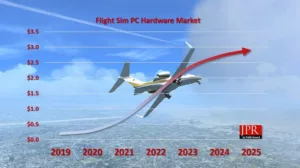Jon Peddie Research (JPR), the global leader in tracking the hardware spend of gamers, has analyzed the sales impact of the release of Microsoft Flight Simulator 2020. This includes PC builds, processor upgrades, display upgrades, flight sticks and throttles, flight system control units, rudder pedals, simulation pit components such as seats and frames, and VR sales.
JPR analyzed the three levels of Economically Active PC gamers and simulation fans: Entry-Level, Mid-Range, and High-End. Economically Active PC gamers are a subset of the global PC gaming populace who rebuild, buy, and upgrade components and accessories with a higher frequency or “refresh rate.” The amount they spend differs and the probability they are flight sim fans differs by level. The higher the level, the more sim fans there are as a percentage, and the more they spend.
Based on the assumption of a sale of 2.27 million units of Flight Simulator 2020 selling over the next three years, JPR estimates that in that time frame $2.6 billion will be spent on hardware with the specific intent of improving the gaming experience. Much more will be spent over the title’s complete sales cycle.
Ted Pollak, Senior Analyst Gaming Industry said “Flight simulators are incredibly demanding on processing capability and reward high resolution, large displays, and VR use. When new flight simulators are released, the hardware to run them at max settings and performance does not even exist yet. This creates a situation of constant hardware demand over the life of the title as fans chase the best experience. A significant number of flight sim fans only play flight sim. We took this into account when calculating whether the money will be spent specifically or partially because of this game.”
Pricing and Availability
Jon Peddie. President of JPR said “beneficiaries of the Microsoft Flight Sim 2020 release will be Intel and AMD due to the demand flight simulators place on CPUs. The framerate can only be drawn when all physical calculations are resolved, and simulations need more physical and environmental resolving by the CPU than normal games. Simulation gamers know the CPU is not easily upgraded so they pay for the best. Nvidia, AMD, and Intel’s GPU offerings will also benefit as that processing is needed for high resolutions. Dell, HP, Lenovo, and other gaming PC builders are also going to see a significant sales boost from this release. As will HP and other VR headset makers with supported products. Of course, all the top PC component and accessory makers will also cash in on the release.
The Worldwide PC Gaming Hardware Market report series by Jon Peddie Research which covers 33 countries, notebooks, desktops, DIY, and accessories, comes in three versions: Entry-Level, Mid-Range, and High-End, with a subscription price of $27,500 including a global summary. Subscribers receive all reports twice a year. Reports are also available by segment at $8,250 per issuance. All gaming reports come with consulting services.
About Jon Peddie Research
Dr. Jon Peddie has been active in the graphics and multimedia fields for more than 30 years. Ted Pollak, JPR’s Senior Gaming Analyst, has been following the video game tech market for 22 years. Jon Peddie Research is a technically oriented multimedia and graphics research and consulting firm. Based in Tiburon, California, JPR provides consulting, research, and other specialized services to technology companies in a variety of fields including graphics development, multimedia for professional applications and consumer electronics, high-end computing, gaming/simulation, and Internet-access product development.

